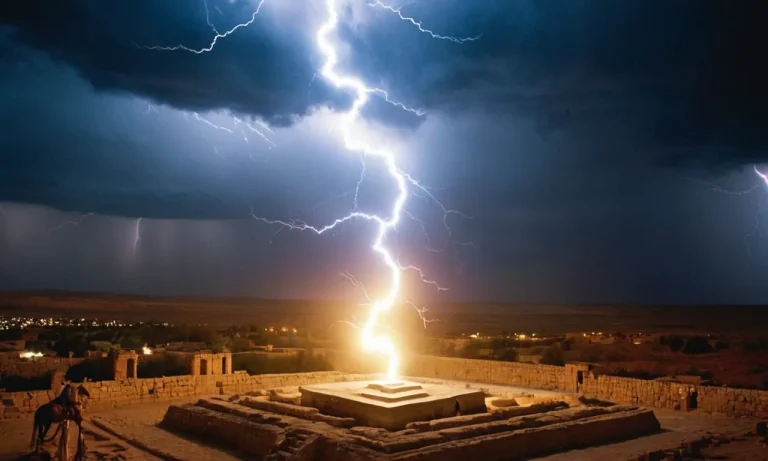What Is Reconciliation In The Bible? A Complete Guide
Reconciliation is a central theme in the Bible that speaks to restoring broken relationships, both between God and humans and between people. If you’re short on time, here’s a quick answer:
In this comprehensive guide, we will explore the biblical foundation for reconciliation, key examples of reconciliation stories in the Bible, and what true reconciliation requires according to Scripture.
We’ll also discuss the role of forgiveness, repentance, justice, and sacrifice in the reconciliatory process.
Finally, we’ll examine what reconciliation means for Christians today who seek to apply biblical principles to healing divisions in their relationships and communities.
The Biblical Basis for Reconciliation
Old Testament Precedent
The concept of reconciliation has its roots in the Old Testament. God calls His people to be reconciled to Him and one another.
For example, in the books of Leviticus and Numbers, God establishes practices and rituals of atonement and forgiveness that allow His people to be cleansed of sin and restored in their relationship with Him (Leviticus 16:30, Numbers 5:8).
These practices create a pathway for reconciliation.
Later prophets, like Isaiah, speak of God’s future work of reconciliation through a suffering servant who will bear the sins of the people (Isaiah 53:5-6).
This sets the stage for the fuller revelation and fulfillment of reconciliation that comes in the New Testament.
New Testament Fulfillment in Christ
In the New Testament, Jesus Christ fulfills the Old Testament promise of reconciliation. Through his atoning death and resurrection, Jesus provides the basis for forgiveness, restoration, and renewed relationship between God and human beings.
Several key Biblical passages highlight this theme of reconciliation accomplished in and through Jesus Christ (see Romans 5:10-11, 2 Corinthians 5:18-20, Ephesians 2:14-18, and Colossians 1:19-23).
Through Christ, broken relationships are restored as God reconciles sinful human beings to Himself. Christ tears down barriers to relationship with God, making peace and reconciliation possible.
The New Testament writers call those who put their faith in Christ to be ambassadors of reconciliation to others.
Key Examples of Reconciliation in Scripture
Esau and Jacob in Genesis
One of the most dramatic stories of reconciliation in the Bible involves twin brothers Esau and Jacob.
As the older brother, Esau was in line to receive his father Isaac’s blessing and birthright. However, Jacob tricked their father into giving him the blessing instead (Genesis 27).
This caused great bitterness between the brothers for many years.
However, when the brothers finally met, Esau ran to Jacob and embraced him, and they wept together (Genesis 33:4). Esau had forgiven his brother.
This powerful reconciliation reminds us that with God’s help, even longtime grievances between family members can be healed.
Joseph and His Brothers in Genesis
Another remarkable instance of reconciliation in the Bible is the story of Joseph and his brothers in Genesis 37-45. Joseph’s brothers hated him so much that they plotted to kill him. At the last minute they decided to sell him into slavery instead.
They told their father Jacob that Joseph had been killed by a wild animal.
Years later, during a famine, the brothers went to Egypt looking for food, not realizing that Joseph had become second-in-command to Pharaoh.
In an amazing act of forgiveness, Joseph revealed himself to his brothers and assured them he would provide for them (Genesis 45:3-15).
Joseph told them not to be distressed because God had used their evil actions for good. What an incredible example of reconciliation and redemption!
Philemon and Onesimus in Philemon
The New Testament book of Philemon provides a model of reconciliation between a slave owner and slave. Onesimus was a runaway slave who encountered the apostle Paul in prison. Paul led Onesimus to faith in Christ.
He persuaded Onesimus to return to his master, Philemon, and encouraged Philemon to welcome Onesimus back not just as a slave but as a brother in Christ (Philemon 16).
Paul’s letter to Philemon appealing for Onesimus’ forgiveness and freedom has been influential in reforming attitudes about slavery. It illustrates how through Christ, relationships marred by injustice can be transformed.
Philemon and Onesimus represent the power of the gospel to break down barriers and bring reconciliation.
Requirements for True Reconciliation
Sincere Repentance
For true reconciliation to take place, there must be sincere repentance on the part of the offender (Luke 17:3-4).
This means honestly acknowledging the wrong that was committed, taking responsibility for it, and being genuinely sorry for the pain caused (Psalm 51:17).
Expressing remorse through both words and changed actions is key.
Complete Forgiveness
The offended person must make a conscious choice to forgive completely (Matthew 18:21-22).
This does not mean denying or minimizing the seriousness of the offense, but rather releasing the right to resentment and not holding a grudge (Ephesians 4:31-32).
Forgiveness is an act of the will, powered by God’s grace.
Restorative Justice
Steps should be taken to restore what was lost or stolen and make amends for damages (Luke 19:8).
The goal is to repair broken relationships and systems, not just say “I’m sorry.” This may involve restitution, changes in behavior, and acts of service.
Rebuilding Trust
Finally, trust needs to be re-established over time through changed attitudes and consistent actions (Proverbs 3:5-6).
Honesty, vulnerability, patience, and understanding are needed. This is an ongoing process, not a one-time event. As trust deepens, true reconciliation can flourish.

The Role of Christ’s Sacrifice in Reconciliation
Bridging the Divine-Human Divide
The sacrificial death of Jesus Christ is central to the Christian understanding of reconciliation between God and humanity.
When sin entered the world, it created a chasm between a holy God and sinful humanity that we could not bridge on our own (Isaiah 59:2).
No amount of human effort can span this divide, because even our righteous acts are like filthy rags before a perfect God (Isaiah 64:6). We need someone to intervene on our behalf and restore the broken relationship.
Jesus willingly took on the punishment we deserved by dying on the cross, so that through faith in him, we can be forgiven and reconciled to God (Romans 5:10). What an amazing display of mercy and grace!
Christ’s atoning sacrifice makes reconciliation possible by removing the barrier of sin that separates us from God. Jesus served as the perfect high priest, offering himself as the ultimate sacrifice for sin once for all (Hebrews 7:27).
His shed blood purifies us from the guilt of sin so that we can enter God’s holy presence (Hebrews 9:12-14).
Now, instead of relating to God on the basis of our own righteousness, we can approach him clothed in the perfect righteousness of Christ (2 Corinthians 5:21).
We have the immeasurable privilege of being adopted into God’s family as beloved children (Galatians 4:5-7).
Modeling the Way to Forgiveness
Not only does Christ’s sacrifice reconcile us to God vertically, but it also sets an example for how we can pursue reconciliation horizontally with others. Jesus commands us to forgive as we have been forgiven (Matthew 6:12; Ephesians 4:32).
He modeled this radical forgiveness by willingly enduring injustice and praying for the forgiveness of those who crucified him (Luke 23:34).
What amazing love! When we grasp how much we have been forgiven, it empowers us to extend grace and forgiveness to others rather than holding on to bitterness and resentment.
Through the transformational work of the Holy Spirit, we can reflect God’s reconciling love by pursuing peace even in broken relationships (Matthew 5:9; Romans 12:18).
Christ tears down walls of hostility and brings diverse people together in him as one new humanity (Ephesians 2:14-18).
The church is meant to be an ambassador of reconciliation and a display of God’s wisdom to the rulers and authorities in the heavenly realms (2 Corinthians 5:18-20; Ephesians 3:10).
When believers lay aside differences and demonstrate supernatural love for one another, it testifies to the unifying power of the gospel. The sacrificial love of Jesus provides both the pattern and the power for reconciliation in all our relationships.
Applying Biblical Reconciliation Today
Overcoming Racial and Ethnic Divisions
Racial injustice and ethnic conflicts continue to divide communities today. However, the Bible calls believers to “make every effort to keep the unity of the Spirit through the bond of peace” (Ephesians 4:3).
Reconciliation requires overcoming biases, listening to understand different perspectives, confessing prejudices, and seeking forgiveness.
Churches can lead the way in modeling interracial harmony and ethnic inclusion. This may involve diversifying leadership, incorporating other cultural styles of worship, preaching on ethnic equality, and facilitating open dialogues between groups.
As Dr. Martin Luther King Jr. famously said, “We must learn to live together as brothers, or perish together as fools.”
Biblical reconciliation provides a vision of unity amid diversity, one rooted not in colorblindness but in the imago Dei—the truth that every person bears God’s image.
Healing Broken Churches and Communities
Division is sadly common in many churches today due to differences in theology, politics, leadership style, or worship music.
However, Scripture urges believers to “make every effort to keep the unity of the Spirit through the bond of peace” (Ephesians 4:3).
Reconciling broken churches begins with leaders modeling humility and grace.
Facilitating open, non-combative dialogue focused on core values can help build trust and understanding across factions. Compromise regarding secondary issues may be necessary for the greater good of harmony.
For communities divided by partisan ideology, interfaith events where political rivals serve alongside each other can foster humanizing relationships. Peacemaking efforts must appeal to people’s shared hopes versus just their differing positions on issues.
Restoring Family Relationships
From sibling squabbles to generational gaps between parents and children, family tension can seem inevitable. Yet Scripture commands us to “not let the sun go down while you are still angry” (Ephesians 4:26) and to “bear with each other and forgive one another” (Colossians 3:13).
Reconciliation requires a willingness to admit wrongdoing, seek forgiveness, let go bitterness, and pursue genuine understanding of other’s perspectives.
Outside Christian mediation through counseling or support groups can help families work through core issues driving conflict.
Restoring family unity is not easy, but vital for relational health and effective Christian witness. As 1 Peter 3:8 reminds households of faith, “Live in harmony with one another; be sympathetic, love as brothers, be compassionate and humble.”
Conclusion
In conclusion, biblical reconciliation is rooted in Scripture’s overarching narrative of God’s work to redeem and restore broken relationships through Christ’s atoning sacrifice.
As Christians seeking to apply biblical principles, we are called to humbly pursue reconciliation in our own relationships by fully forgiving others, sincerely repenting of sins, and sacrificing personal interests out of love for others.
While challenging in practice, the reconciliatory way of Christ offers hope for healing deep divides and brings glory to God by demonstrating the reconciling power of the gospel.








